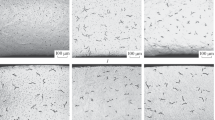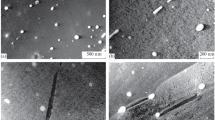Abstract
The velocity of delayed hydride cracking in irradiated É110 alloy (0.01% hydrogen) and zircalloy-2 (0.078% hydrogen) is predicted. It is shown that the velocity of cracking in VVÉR and RBMK fuel-element cladding is lower than in the stronger BWR fuel-element cladding. The maximum predicted velocity of cracking in É110 alloy is 2·10–7 m/sec and is reached at 533 K. Below this temperature, the cracking process in both materials studied follows the Arrhenius law with activation energy 53–56 kJ/mole.
Similar content being viewed by others
REFERENCES
J. Ambler, “Effect of the direction of approach to temperature on the delayed hydrogen cracking behavior of cold-worked Zr‐2.5Nb,” in: 6th International Symposium on Zr in the Nuclear Industry (1984), pp. 653–674.
P. Efsing and K. Pettersson, “Delayed hydride cracking in irradiated zircalloy cladding,” in: 12th International Symposium on Zr in the Nuclear Industry (2000), pp. 340–355.
B. Kammenzind, B. Berquist, R. Bajaj, et al., “The long-range migration of hydrogen through zircalloy in response to tensile and compressive stress gradients,” ibid., pp. 196–233.
A. A. Shmakov, E. A Smirnov, and H. Bruhertsoifer, “Hydrogen distribution and diffusion in oxidized zirconium alloys,” At. Énerg., 85, No.3, 253–255 (1998).
A. A. Shamkov, B. A. Kalin, and A. G. Ioltukhovskii, “Theoretical invetigation of the kinetics of hydride cracking in zirconium alloys,” Metalloved. Termich. Obrab. Metal. No. 8, 35–40 (2003).
A. McMinn, E. Darby, and J. Schofield, “The terminal solid solubility of hydrogen in zirconium alloys,” in: 12th International Symposium on Zr in the Nuclear Industry (2000), pp. 173–195.
M. Puls, “The effects of misfit and external stresses on terminal solid solubility in hydride-forming metals,” Acta Met., 29, 1961–1968 (1981).
G. P. Kobylyanskii and A. E. Novoselov, Radiation Resistance of Zirconium and Zirconium-Based Alloys. Reference Data on Reactor Materials Engineering GNTS RF NIIAR, Dimitrovgrad (1996).
S. Shi, “Diffusion-controlled hydride growth near crack tip in zirconium under temperature transients,” J. Nucl. Mater., 275, 318–323 (1999).
M. I. Solonin, L. P. Sinel'nikov, V. A. Tsykanov, et al., “Materials engineering problems of long-time wet and dry storage of spent RBMK-1000 nuclear fuel elements,” in: Proceedings of the 6th Russian Conference on Reactor Materials Engineering, Vol. 2, Part 2, GNTS RF NIIAR, Dimitrovgrad (2001), pp. 3–22.
D. Wappling, A. R. Massih, and P. Stahle, “A model for hydride-induced embrittlement in zirconium-based alloys,” J. Nucl. Mater., 249, 231–238 (1997).
Author information
Authors and Affiliations
Rights and permissions
About this article
Cite this article
Shmakov, A.A., Kalin, B.A. & Smirnov, E.A. Calculation of the Hydride Cracking Velocity in Irradiated Fuel Elements of Light-Water Reactors. Atomic Energy 95, 776–780 (2003). https://doi.org/10.1023/B:ATEN.0000016763.01624.d9
Issue Date:
DOI: https://doi.org/10.1023/B:ATEN.0000016763.01624.d9




